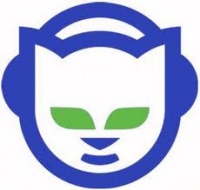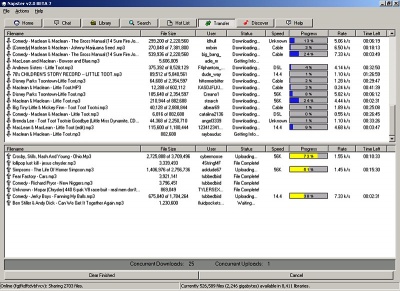Napster
Napster, was a free peer-to-peer file sharing sharing program created in 1999 by co-founders Sean Parker and Shawn Fanning. At its peak in the early 2000's there were over 20 million users, the majority being college students. Napster was the first file sharing software in which users could download music from other users, rather than from a central computer. Napster was the target of many copyright infringement lawsuits from artists, record labels, and others in the music industry. The legal controversy eventually led to the downfall of the P2P file sharing software which was court ordered to shut down immediately in 2001[1].
Contents
Early History
Napster was created by Shawn Fanning at the age of 18 in his dorm room at Northeastern University in Boston, MA. [2] Fanning was not happy with the current inconvenience of finding downloadable music online, and took it upon himself to improve the system. He wanted a program capable of sharing music with his friends, as a result Fanning stayed up for 60 hours coding the program. Fanning and his friend Sean Parker raised $50,000 in investments and launched a beta version of their software in June 1999. Over the next twelve months the program gained tens of millions of users worldwide and was considered one of the fastest growing web applications of its time.[3]
How the Original Napster Worked
Napster was a unique way of distributing MP3 files because the songs lived on users' machines, rather than being stored on a central computer. This is known as peer-to-peer sharing (P2P) and revolves around downloading music directly from other people's machines, no matter how close or far in proximity they may be. To download a song on Napster, internet connection first had to be established. Once this was checked, the user was logged into the central server which kept track of how many Napster users were online at that moment and connected them. The user than typed in the song or artist they were searching for. The index server was then searched for other computers currently using Napster that contained the song the user was searching for. When a match was found, the users computer was alerted of where to find the file that had been searched for. A list was then generated in the users' Winder after the server replied showing the options of that song that could be downloaded. The user would then click on the song(s) that interested them and choose Download. Napster would then check to make sure internet connection was established between the user and the computer system hosting the file they had chosen. If this connection was established, the song would begin to download. Once finished downloading, the users computer would be disconnected from the host and the MP3 could be listened to any time by opening the player software. [4]
Ethical Issues
Due to its rapid growth in users, in 2001, members the of the Recording Industry Association of America took notice of the copyright infringement on the site. Many artists such as Metallica and Dr. Dre, through the RIAA, sued Fanning and his team for facilitating free trade of illicit music files, a direct violation of Copyright law.[5] It was estimated that over 2.79 billion songs were illegally transferred during Napster's peak month, February 2001. Napster argued that because the music files were never in their own possession, and rather transferred directly between users, that Napster had no legal responsibility. As court proceedings progressed, one point of debate was the criminality of Napster users.
Users
Although it is clear that Napster services raise an ethical question revolving copyright infringement, there are many issues dealing with Napster's actual role in the copyright violations, as well as Napster's ability to update its software to protect copyrighted information. Users are directly at fault for illegally exchanging information over the Napster service and technically, Napster is not doing anything illegal. None of the material exchanged on Napster's site is actually held on a Napster server and this is one of the first things mentioned in the Napster Copyright Policy website. Napster believes that it only acts as a forum for exchange, and thus cannot be held liable for the illegal exchange of information, even though the open forum acts as a space for unethical practices. This in itself may keep Napster from legal punishment but it is still an ethical violation. Napster is fostering infringement upon the rights of artists who own copyrighted material and Napster should take certain measurements to avoid this infringement upon copyrighted material [6].
Bertelsmann Acquisition and Shutdown
In 2001, a German media company, Bertelsmann, agreed to a partnership with Napster to transform it into a membership-based music catalog. Bertelsmann promised a membership-based distribution system that would pay money to artists. Amidst the new partnership, the lawsuit still continued. In July 2001, the The 9th U.S. Circuit Court of Appeals issued an injunction for Napster to immediately shutdown in order to prevent the trading of copyrighted music on its network. In the last days, usage of the software spiked 71% as users tried to get as much music as possible before the shutdown.
Transformation to legal service
Over next decade Napster went through many acquisitions and changes as the software company attempted to reemerge with a legal form of Napster. Below is the series of acquisitions and key events:[7]
September 2001 - Napster settles its suits against the RIAA and agrees to pay $26 million in damage for all previously traded music and a downpayment of $10 million dollars for future royalties.
September 3, 2002 - Napster files for bankruptcy and is forced to liquidate all assets.
2003 - Napster was bought by Roxio, a software company that produces digital media products. Roxio acquired Napster through a bankruptcy auction and intended to relaunch the Napster as a digital retail music distributer, similar to iTunes
2008 - Best Buy, the consumer electronics superstore, agrees to pay $121 million to Roxio to compete with then rival Circuit City.
October 2011 - Best Buy no longer wanted apart of the crowded digital music industry and sold the Napster brand to Rhapsody. Rhapsody had no intentions to continue Napster, but purchased it specifically for its intellectual property and notoriety. Napster was absorbed into the Rhapsody brand and is currently operating under the Rhapsody name.[8]
Napster in Popular Culture
There have been several books that document the experiences of people working at Napster, including Joseph Menn's Napster biography, All the Rave: The Rise and Fall of Shawn Fanning's Napster, John Alderman's "Sonic Boom: Napster, MP3, and the New Pioneers of Music," and Steve Knopper's "Appetite for Self Destruction: The Spectacular Crash of the Record Industry in the Digital Age.[9] Paraodies of Napster references have also been seen in the popular television shows Futurama and South Park. Tom Smith and Johnny Crass both also made parody songs about Napster. In the recent film, "Get Him To The Greek" there is a reference to Napster. Producer/Director/Actor Eli Roth also made a small film with a parody about Napster called "Snackster" in reference to copyright infringement. Also, the 2010 film The Social Network features Napster founder Sean Parker, as well as his role in the rise of the popular website Facebook. [9]
See Also
- Bandcamp
- Digital Piracy
- File Sharing
- iTunes Store
- Kazaa
- Limewire
- Pandora
- Rhapsody
- Sampling (hip hop)
References
- ↑ Judge Nixes Napster CNN Technology
- ↑ Napster History
- ↑ Napster among fastest-growing Net technologies
- ↑ How the Original Napster Worked
- ↑ A Brief History of Filesharing: From Napster to Legal Music Downloads
- ↑ http://www.123helpme.com/assets/10711.html
- ↑ Early history of Napster
- ↑ Rhapsody to buy Napster from Best Buy
- ↑ 9.0 9.1 Business Insider

